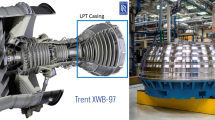Abstract
Run out is one of the major problems in microdrilling processes, causing unexpectedly short tool life, sudden breakage, and dimensional inaccuracy. In this study, a two-step monitoring system for run out detection is proposed. The first step uses the fast Fourier transform for extracting features from the online measured force signals. In the second step, a neural network-based model predicts the process condition from the previously obtained features. The model was trained and tested by using force signals obtained from tungsten and titanium alloys, which are widely applied in electronic and aerospace industries. A 0.1-mm-diameter microdrill was used in the experimental study, and three different feed rates were applied for each material. The trained model was validated with data that was not used in the training process. In this validation, the system was able to detect more than 70 % of the run out conditions with less than 10 % of false detections. For microdrills, detecting and reducing run out can yield considerable gains in tool life and productivity.
Similar content being viewed by others
References
Krimpenis AA, Fountas NA, Ntalianis I, Vaxevanidis NM (2014) CNC micromilling properties and optimization using genetic algorithms. Int J Adv Manuf Technol 70:157–171. doi:10.1007/s00170-013-5248-7
Watanabe H, Tsuzaka H, Masuda M (2008) Microdrilling for printed circuit boards (PCBs)—influence of radial run out of microdrills on hole quality. Precis Eng 32:329–335. doi:10.1016/j.precisioneng.2008.02.004
Kudla LA (2006) Deformations and strength of miniature drills. Proc Inst Mech Eng B J Eng 220:389–396. doi:10.1243/095440505X69346
Beruvides G, Quiza R, del Toro R, Haber RE (2013) Sensoring systems and signal analysis to monitor tool wear in microdrilling operations on a sintered tungsten–copper composite material. Sens Actuators A Phys 199:165–175. doi:10.1016/j.sna.2013.05.021
Imran M, Mativenga PT, Gholinia A, Withers PJ (2011) Evaluation of surface integrity in micro drilling process for nickel-based superalloy. Int J Adv Manuf Technol 55:465–476. doi:10.1007/s00170-010-3062-z
Tran NK, Lam YC, Yue CY, Tan M-J (2012) Evaluation of roughness, hardness, and strength of AA 6061 molds for manufacturing polymeric microdevices. Int J Adv Manuf Technol 60:1215–1221. doi:10.1007/s00170-011-3673-z
Yao X, Zhang Y, Li B, Zhang Z, Shen X (2013) Machining force control with intelligent compensation. Int J Adv Manuf Technol 69:1701–1715. doi:10.1007/s00170-013-5136-1
Malekian M, Park SS, Jun MB (2009) Tool wear monitoring of micro-milling operations. J Mater Process Technol 209:4903–4914. doi:10.1016/j.jmatprotec.2009.01.013
Fu L, Ling SF, Tseng CH (2007) On-line breakage monitoring of small drills with input impedance of driving motor. Mech Syst Signal Process 21:457–465. doi:10.1016/j.ymssp.2005.04.004
Sick B (2002) On-line and indirect tool wear monitoring in turning with artificial neural networks: a review of more than a decade of research. Mech Syst Signal Process 16:487–546. doi:10.1006/mssp.2001.1460
Zhu K, Wong YS, Hong GS (2009) Wavelet analysis of sensor signals for tool condition monitoring: a review and some new results. Int J Mach Tool Manuf 49:537–553. doi:10.1016/j.ijmachtools.2009.02.003
Li X (2001) Detection of tool flute breakage in end milling using feed-motor current signatures. IEEE-ASME Trans Mech 6:491–498
Kim DW, Lee YS, Park MS, Chu CN (2009) Tool life improvement by peck drilling and thrust force monitoring during deep-micro-hole drilling of steel. Int J Mach Tool Manuf 49:246–255. doi:10.1016/j.ijmachtools.2008.11.005
Suprock CA, Roth JT (2007) Methods for on-line directionally independent failure prediction of end milling cutting tools. Mach Sci Technol 11:1–43. doi:10.1080/10910340601174806
Kondo E, Shimana K (2012) Monitoring of prefailure phase and detection of tool breakage in micro-drilling operations. Procedia CIRP 1:581–586. doi:10.1016/j.procir.2012.05.003
Patra K, Pal SK, Bhattacharyya K (2007) Application of wavelet packet analysis in drill wear monitoring. Mach Sci Technol 11:413–432. doi:10.1080/10910340701539908
Shi D, Gindy NN (2007) Development of an online machining process monitoring system: application in hard turning. Sensors Actuators A Phys 135:405–414. doi:10.1016/j.sna.2006.08.011
Ganesan R (2008) Real-time monitoring of complex sensor data using wavelet-based multiresolution analysis. Int J Adv Manuf Technol 39:543–558. doi:10.1007/s00170-007-1237-z
Chen Z, Zhang X (2005) Monitoring of tool wear using feature vector selection and linear regression. 1st ICNC, Springer, Changsha, China. doi: 10.1007/11539117_1
Palanisamy P, Rajendran I, Shanmugasundaram S (2007) Prediction of tool wear using regression and ANN models in end-milling operation. Int J Adv Manuf Technol 37:29–41. doi:10.1007/s00170-008-1758-0
Kuo RJ (2000) Multi-sensor integration for on-line tool wear estimation through artificial neural networks and fuzzy neural network. Eng Appl Artif Intell 13:29–261. doi:10.1016/S0952-1976(00)00008-7
Ren Q, Balazinski M, Baron L, Jemielniak K (2011) TSK fuzzy modeling for tool wear condition in turning processes: an experimental study. Eng Appl Artif Intell 24:260–265. doi:10.1016/j.engappai.2010.10.016
Sokolowski A (2004) On some aspects of fuzzy logic application in machine monitoring and diagnostics. Eng Appl Artif Intell 17:429–437. doi:10.1007/s10845-012-0623-z
Kassim AA, Mian Z, Mannan MA (2006) Tool condition classification using hidden Markov model based on fractal analysis of machined surface textures. Mach Vis Appl 17:327–336. doi:10.1007/s00138-007-0085-z
Liao TW, Hua G, Qu J, Blau PJ (2006) Grinding wheel condition monitoring with hidden Markov model-based clustering methods. Mach Sci Technol 10:511–538. doi:10.1080/10910340600996175
Zhu K, Wong YS, Hong GS (2009) Multi-category micro-milling tool wear monitoring with continuous hidden Markov models. Mech Syst Signal Process 23:547–560. doi:10.1016/j.ymssp.2008.04.010
Wang G, Feng X (2013) Tool wear state recognition based on linear chain conditional random field model. Eng Appl Artif Intell 26:1421–1427. doi:10.1016/j.engappai.2012.10.015
Panda SS, Chakraborty D, Pa SK (2007) Monitoring of drill flank wear using fuzzy back-propagation neural network. Int J Adv Manuf Technol 34:227–235. doi:10.1007/s00170-006-0589-0
Huang CK, Wang LG, Tang HC, Tarng YS (2006) Automatic laser inspection of outer diameter, run out and taper of micro-drills. J Mater Process Technol 171:306–313. doi:10.1016/j.jmatprotec.2005.06.085
Author information
Authors and Affiliations
Corresponding author
Rights and permissions
About this article
Cite this article
Beruvides, G., Quiza, R., Rivas, M. et al. Online detection of run out in microdrilling of tungsten and titanium alloys. Int J Adv Manuf Technol 74, 1567–1575 (2014). https://doi.org/10.1007/s00170-014-6091-1
Received:
Accepted:
Published:
Issue Date:
DOI: https://doi.org/10.1007/s00170-014-6091-1




